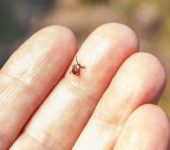
Posted On:
Category: Category:
Alternative EarthCare Discusses Checking for Ticks on Long Island: How to Check for Ticks and What to Do When They’re Found
OCTOBER 13, 2019
LONG ISLAND, N.Y.
Long Islanders have an on-going battle with disease-spreading ticks. The east-end, particularly, is a hotbed of tick activity. With outdoor season beckoning, it’s essential that east-end Long Island Residents know how to check for ticks and what to do when they find them. Alternative EarthCare discusses checking for ticks on the east end; how to check for ticks and what to do when they’re found.
After time spent outdoors, Long lslander’s should always conduct a body and head check, especially during peak season. Though ticks can overwinter, the spring marks the start of their most active season, which goes through fall. A body check should occur as soon as possible after being outdoors to minimize the chances of contracting a dangerous tick-borne illness. While typically it takes 24 to 48 hours for ticks to transmit diseases, in some cases, such as with the transmission of the Powassan virus, transmission can occur in less than an hour, so time is of the essence.

Ticks typically climb onto hosts from blades of tall vegetation and climb upward. Their most common hosts, such as rodents, small mammals, and deer, have thinner skin near the neck and head, so as a matter of instinct, ticks tend to climb upwards for easy access to blood. This means that checking the head, neck, and scalp is immensely important and shouldn’t be forgotten about. Start checking near the feet and ankles and work your way up by running fingers along the skin. Since ticks can be as small as the head of a pin, a visual scan alone is not enough. Be sure to check in ears and thoroughly rub the scalp to feel for any ticks that may be crawling or already attached. On pets, rub fingers through the fur with enough pressure to get to the skin and feel for small bumps.
If a tick is found, they should be removed with tweezers as close to the mouth-part as possible with a firm grasp and pull. Be careful to get as close as possible to the point of entry to avoid the tick’s back-end being ripped off with the mouth-part still left in the skin. After a tick is removed, clean the area with rubbing alcohol, iodine, or soapy water. Watch the area for any sign of a rash to appear which could be the sign of a tick-borne disease. If any signs of a rash appear, see a doctor immediately for treatment. The sooner treatments begin, the better. In the case of pets, they may not show any signs of distress, and it can be difficult to notice rashes or irritations through the fur, so it’s best to bring bitten pets to the vet for testing and treatment.
Always take precautions against tick bites by wearing insect repellant when outdoors, avoiding habitats such as wooded areas during peak season, and always obtain professional property treatments to protect family, friends, and pets.
Serving both Suffolk and Nassau County, including the East End of Long Island and the Hamptons. Alternative EarthCare offers a variety of organic, non-toxic lawn care services for your home or business. In addition to beautifying and maintaining properties, the award-winning staff is also dedicated to the safety and health of their customers.










